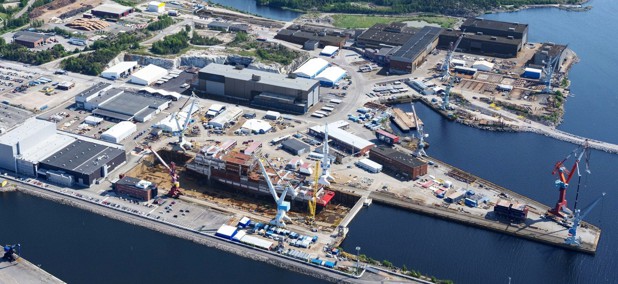World
U.S. Shipbuilding at Risk Amid Icebreaker Deal with Finland

The recent agreement between the United States and Finland to construct U.S. Coast Guard icebreakers has raised concerns about the future of American shipbuilding. On October 9, former President Donald Trump signed a memorandum of understanding that allows for the initial four icebreakers to be built in Finnish shipyards, followed by seven in American facilities. This arrangement has sparked debate over the potential implications for the U.S. maritime industry.
Jerry Hendrix, who leads the White House Shipbuilding Office, praised the deal, highlighting it as a manifestation of Trump’s negotiation skills. He suggested that similar agreements could pave the way for foreign construction of U.S. Navy warships. Critics, however, warn that this approach may undermine the long-term viability of American shipbuilding and the broader goal of a maritime renaissance.
The necessity for the United States to maintain its shipbuilding capacity is underscored by historical precedents. The success of the U.S. Navy in the Battle of Midway can be attributed to a robust shipbuilding program that ensured the fleet was able to replace losses quickly. Currently, however, America’s shipbuilding capabilities have diminished due to past policy decisions that curtailed government support for commercial shipping and led to consolidation in the industry.
The Trump administration has been engaged in efforts to revitalize the U.S. shipbuilding sector, notably through alliances with foreign shipbuilders. The Maritime Statecraft strategy, conceptualized under the leadership of Navy Secretary Carlos Del Toro, emphasizes the need for world-class shipbuilders to invest in American shipyards. This strategy has already seen successes, such as Hanwha acquiring the Philly Shipyard and committing to a significant investment to modernize operations.
While foreign investment can be beneficial, critics argue that outsourcing naval shipbuilding compromises the technical security of U.S. designs and systems. Moreover, the strategic vulnerability of allied shipyards in proximity to rival nations poses additional risks. By agreeing to outsource icebreaker construction, the U.S. may be relinquishing a vital negotiating position in the shipbuilding market.
The upcoming Asia Pacific Economic Community summit in South Korea presents an opportunity for the U.S. to solidify its maritime strategy. During recent tariff negotiations, the South Korean government proposed the “Make American Shipbuilding Great Again” initiative, which includes $150 billion in loans and guarantees to support U.S. shipbuilding investments. This proposal aligns with U.S. laws requiring warships to be built domestically.
However, Trump’s icebreaker agreement with Finland could jeopardize these potential advancements. The precedent set by this deal, coupled with comments made by Trump suggesting a willingness to consider outsourcing further, could undermine the progress made in securing Korean investment in American shipbuilding.
As discussions unfold at the summit, the implications of the icebreaker deal could become clearer. The U.S. must carefully navigate its position to avoid sacrificing long-term investment in its maritime industry for short-term gains. Maintaining a strong domestic shipbuilding capability is crucial for national security and the future of American seapower.
In conclusion, the decision to outsource icebreaker production raises significant questions about America’s maritime strategy. A commitment to domestic shipbuilding is essential to ensure that the U.S. retains control over its naval capabilities while fostering an environment that attracts foreign investment. The ongoing negotiations with South Korea could represent a pivotal moment for the future of American shipbuilding and maritime strength.
-

 Science2 weeks ago
Science2 weeks agoIROS 2025 to Showcase Cutting-Edge Robotics Innovations in China
-

 Politics2 weeks ago
Politics2 weeks agoJudge Considers Dismissal of Chelsea Housing Case Citing AI Flaws
-

 World2 weeks ago
World2 weeks agoBravo Company Veterans Honored with Bronze Medals After 56 Years
-

 Lifestyle2 weeks ago
Lifestyle2 weeks agoStone Island’s Logo Worn by Extremists Sparks Brand Dilemma
-

 Top Stories2 weeks ago
Top Stories2 weeks agoIndonesia Suspends 27,000 Bank Accounts in Online Gambling Crackdown
-

 Sports2 weeks ago
Sports2 weeks agoMel Kiper Jr. Reveals Top 25 Prospects for 2026 NFL Draft
-

 Health2 weeks ago
Health2 weeks agoStartup Liberate Bio Secures $31 Million for Next-Gen Therapies
-

 Health2 weeks ago
Health2 weeks agoTop Hyaluronic Acid Serums for Radiant Skin in 2025
-

 World2 weeks ago
World2 weeks agoHoneywell Predicts Record Demand for Business Jets Over Next Decade
-

 Politics2 weeks ago
Politics2 weeks agoNew Jersey Voters Urged to Register Ahead of November Election
-

 Lifestyle2 weeks ago
Lifestyle2 weeks agoMary Morgan Jackson Crowned Little Miss National Peanut Festival 2025
-

 Sports2 weeks ago
Sports2 weeks agoYamamoto’s Mastery Leads Dodgers to 5-1 Victory in NLCS Game 2









